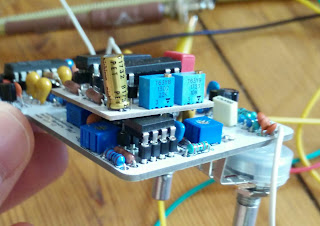The jordan vico vibe interested me in early 2012 mainly because it's so simple. As a rookie solder jockey that wanted to build every type of pedal to try them all the specs sounded very appealing. The tremolo circuit is about as complicated as a fuzz face (the pedal I built before that) and didn't use any optocouplers .
Of course it's a little more complicated than that. The vico vibe is reported to have a volume drop when engaged and the circuit is kind of unusual. It doesn't have any buffers, just two resistors and an LFO that periodically dumps all signal to ground to create the tremolo effect.
This is the classic schematic as found online:
IvIark made a vero layout for this:
I assumed the volume drop needed to be counteracted with a boost circuit, so I built an SHO mosfet boost and connected it right after the circuit. The volume would be set with a trim pot and another trim pot was used to bias the vico vibe circuit.
I connected these two circuits in series in one box and after careful calibration by ear they sound great. This is vital, though, as the DEPTH and TRIM control interact and trim set too much to either direction will affect the minimun depth, which will make the tremolo disappear.
Here's a picture of the two vico vibes I built:
One is the two vero circuits in one enclosure with two rate controls (red and blue knob) that can be switched with the left footswitch. The other one is both circuits built on one pcb and fits in a 1590A.































